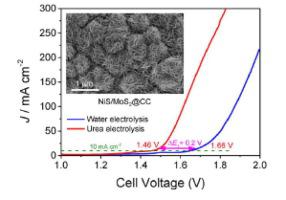Chemical Engineering Journal ( IF 13.3 ) Pub Date : 2022-04-11 , DOI: 10.1016/j.cej.2022.136321 Chengjun Gu 1 , Guangyao Zhou 2 , Jun Yang 3, 4 , Huan Pang 5 , Mingyi Zhang 6, 7 , Qun Zhao 8 , Xuefang Gu 8 , Shu Tian 8 , Jubing Zhang 1 , Lin Xu 1 , Yawen Tang 1

|
Urea-assisted water electrolysis possesses the prospective prospect for high-efficiency hydrogen production by replacing oxygen evolution reaction (OER) with thermodynamically more favorable urea oxidation reaction (UOR). Modulating the electronic structure of electrocatalysts through constructing metal–semiconductor heterointerface represents an effective strategy to promote the electrochemical performances. Herein, we construct a Mott-Schottky bifunctional electrocatalyst by in-situ growth of NiS/MoS2 hetero-nanoflowers on the conductive carbon cloth (CC) substrate (abbreviated as NiS/MoS2@CC hereafter) for both hydrogen evolution reaction (HER) and urea oxidation reaction (UOR). Thanks to the Mott-Schottky effect, the self-driven charge transfer occurs across the NiS/MoS2 heterointerfaces, which results in the built-in electric field, the accelerated charge transfer rate, and the modified chemisorption free energies for reaction intermediates, ultimately expediting the dissociation of water and urea molecules. Consequently, the as-fabricated NiS/MoS2@CC electrode only requires an overpotential of 87 mV for hydrogen evolution reaction (HER) in 1.0 M KOH and a potential of 1.36 V for UOR in 1.0 M KOH solution with 0.5 M urea to attain a current density of 10 mA cm−2, respectively. Moreover, when served as the free-standing anode and cathode simultaneously, the NiS/MoS2@CC-assembled urea electrolyzer requires a cell voltage of 1.46 V at 10 mA cm−2, which is 200 mV smaller than that of the pure water splitting counterpart. This study may deepen the understanding of electronic modulation via Mott-Schottky establishment.
中文翻译:

NiS/MoS2 Mott-Schottky 异质结诱导的局部电荷再分布用于高效尿素辅助节能制氢
尿素辅助水电解具有热力学更有利的尿素氧化反应(UOR)替代析氧反应(OER)高效制氢的前景。通过构建金属-半导体异质界面来调节电催化剂的电子结构是提高电化学性能的有效策略。在此,我们通过在导电碳布 (CC) 基底上原位生长 NiS/MoS 2异质纳米花构建了 Mott-Schottky 双功能电催化剂(简称 NiS/MoS 2@CC 以下)用于析氢反应(HER)和尿素氧化反应(UOR)。由于 Mott-Schottky 效应,自驱动电荷转移发生在 NiS/MoS 2异质界面上,从而导致内建电场、加速的电荷转移速率和反应中间体的修饰化学吸附自由能,最终加速水和尿素分子的解离。因此,所制造的 NiS/MoS 2 @CC 电极在 1.0 M KOH 中的析氢反应 (HER) 仅需要 87 mV 的过电位,在具有 0.5 M 尿素的 1.0 M KOH 溶液中的 UOR 的电位为 1.36 V 即可达到10 mA cm -2的电流密度, 分别。此外,当NiS/MoS 2 @CC组装的尿素电解槽同时用作独立的阳极和阴极时,在10 mA cm -2下需要1.46 V的电池电压,比纯水的电压小200 mV。分裂对方。本研究可能通过莫特-肖特基建立加深对电子调制的理解。













































 京公网安备 11010802027423号
京公网安备 11010802027423号